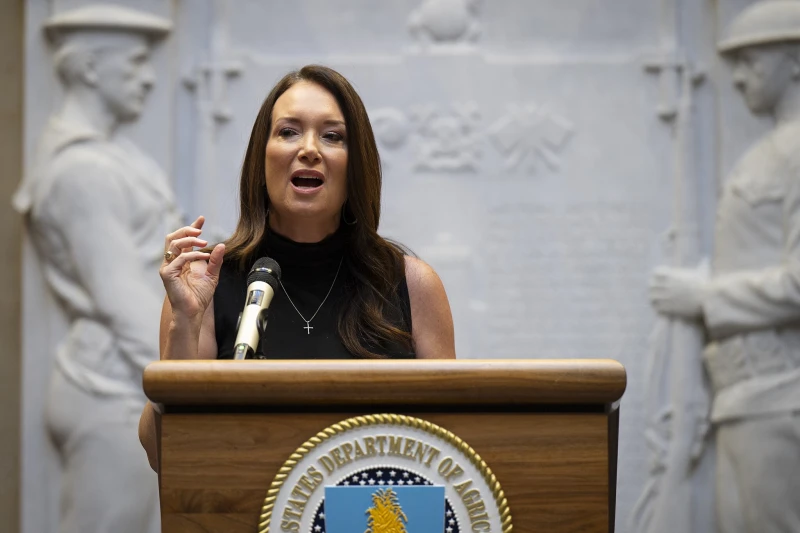

Auxiliary Bishop Jose María García-Maldonado attempts to visit detainees at the Broadview, Illinois, immigration facility and was not admitted Nov. 1, 2025. / Credit: Bryan Sebastian, courtesy of Coalition for Spiritual and Public Leadership
Washington, D.C., Nov 7, 2025 / 18:40 pm (CNA).
The Trump administration this week denounced a Chicago-based federal judge’s ruling that mandated cleanliness and hygiene standards as well as adequate legal representation at a U.S. Immigration and Customs Enforcement (ICE) facility in Illinois.
Government lawyers said Nov. 7 they are in compliance or are in the midst of complying with the judge’s conditions. The detainees’ attorneys, however, say they “are doubtful” the government is “actually in compliance” with some of the conditions, “including as to facility cleaning, the provision of food and water, and the provision of prescription medication.”
The detainees’ attorneys asked the court to conduct an inspection with an expert and have the government provide immediate proof of compliance.
Administration officials said an “activist judge” issued the temporary restraining order and based it on hoaxes, while religious and civil-rights advocates pressed for detainees’ access to the Eucharist.
Access to Communion
A group of 19 spiritual leaders including six priests renewed a request to offer pastoral care and Communion at the Broadview facility in a Nov. 6 letter to ICE and asked to discuss “procedures by which our small delegation of religious ministers can be granted access.” The delegation bringing Communion was denied access Nov. 1.

The judge’s temporary restraining order followed an Oct. 30 lawsuit in which detainees claimed they were placed in unsanitary conditions, provided inadequate food and water, and unconstitutionally deprived of access to legal representation and spiritual care. The Department of Homeland Security (DHS) said ICE’s Broadview facility houses “criminal illegal aliens” whom it described as “some of the worst of the worst.”
“Some of the worst of the worst including pedophiles, gang members, and rapists have been processed through the facility in recent weeks,” Tricia McLaughlin, assistant Homeland Security secretary for public affairs, said in a Nov. 5 statement.
The list included Jose Manuel Escobar-Cardona, described by DHS as “a criminal illegal alien” from Honduras who was convicted of multiple charges of lewd or lascivious acts with a minor, assault, driving under the influence of liquor, making a false report, illegal reentry, and making a false report.
Also named by DHS was Alfonso Batalla-Garcia, “a criminal illegal alien from Mexico, convicted of sex assault, kidnapping an adult to sexually assault, and homicide.”
Other detainees named by DHS included migrants who were said to have been convicted of drug trafficking, kidnapping, first-degree murder, and weapons trafficking.
Publicly reported individuals detained by ICE in November also included a day care worker at the Rayito De Sol center, a Chicago preschool where the woman was removed in front of children.
Pope Leo XIV on Nov. 4 said: “Many people who’ve lived for years and years and years, never causing problems, have been deeply affected by what’s going on right now.” Leo invited authorities to allow pastoral workers to attend to the needs of detainees.
He reminded that “Jesus says very clearly … at the end of the world, we’re going to be asked … how did you receive the foreigner? Did you receive him and welcome him or not? And I think that there’s a deep reflection that needs to be made in terms of what’s happening.”
A detainee testified he spent six days at the Broadview ICE facility before Judge Robert Gettleman ordered bedding, three meals a day, free water, hygiene products, papers translated into Spanish, a clock in each hold room, and free phone service for detainees to talk to counsel. Gettleman also ordered DHS to list all detainees on the Locator Online Detainee Locator System of ICE.
DHS says facilities such as Broadview are designed to serve only as short-term holding centers, typically for about 12 hours, where individuals are briefly held for processing before being moved to longer-term detention facilities.
“Despite hoaxes spread by criminal illegal aliens, the complicit media, and now an activist judge, the ICE Broadview facility does not have subpar conditions,” McLaughlin said. She said detainees receive three meals a day, access to water, and proper medical care.
Neither McLaughlin’s statement nor the judge’s order addressed the lawsuit’s claims that Broadview detainees have been unconstitutionally denied access to faith leaders and clergy.
McLaughlin wrote on X that “religious organizations have ALWAYS been welcome to provide services to detainees in ICE detention facilities. Religious leaders may request access to facilities through proper channels and have those requests approved.”
McLaughlin also responded to questions from CNA, saying dangerous conditions — including belligerent actions and “attacks,” such as the use of tear gas, by protesters — and Broadview’s status as a short-term “field office” have prevented ICE from accommodating requests by religious organizations seeking access to detainees there.
“ICE staff has repeatedly informed religious organizations that, due to Broadview’s status as a field office and the ongoing threat to civilians, detainees, and officers, they are not able to accommodate these requests at this time,” McLaughlin told CNA. “Even before the attacks on the Broadview facility, it was not within standard operating procedure for religious services to be provided in a field office, as detainees are continuously brought in, processed, and transferred out.”
Chicago faith leaders wrote to ICE Nov. 7: “We understand that in past years ministers were granted access to the Broadview ICE facility for pastoral purposes. We also note public statements by DHS acknowledging detainees’ rights to chaplaincy and religious resources, while noting that requests for entry may require advance approval.”
‘Careful review’
Bishop Robert E. Barron of the Diocese of Winona-Rochester, Minnesota, who serves on the Department of Justice’s Religious Liberty Commission, said on X that senior officials in the U.S. government “assured” him that detainees in immigration custody will have access to Catholic sacraments and that the situation is “under careful review.”
The Catholic Legal Immigration Network (CLINIC) said in a email Nov. 7: “CLINIC is disturbed by these instances in which the human and constitutional right to religious practice is being restricted. We hope the administration follows up on its ‘careful review’ by rectifying this and taking further action.”
Pope Leo’s recent exhortation Dilexi Te says: “The Church, like a mother, accompanies those who are walking. Where the world sees threats, she sees children; where walls are built, she builds bridges. She knows that her proclamation of the Gospel is credible only when it is translated into gestures of closeness and welcome. And she knows that in every rejected migrant, it is Christ himself who knocks at the door of the community.”
Read More



![Trump administration expands IVF and other fertility treatment coverage #Catholic
The Trump administration will expand access to in vitro fertilization drugs and procedures. / Credit: sejianni/Shutterstock
CNA Staff, Oct 16, 2025 / 18:53 pm (CNA).
President Donald Trump is expanding access to in vitro fertilization and other fertility treatments by partnering with pharmaceutical companies and expanding insurance options. According to a White House announcement on Oct. 16, the Trump administration is working with major pharmaceutical companies to bring IVF drugs to the U.S. at lower prices. The administration is also expanding insurance coverage for fertility care.The agreement with leading pharmaceutical group EMD Serono will make IVF drugs available “at very, very heavily reduced prices — prices that you won’t even believe,” Trump said on Thursday in a livestream from the Oval Office. According to the announcement, women who buy directly from TrumpRx.gov, a website that will launch in January 2026, will get a discount equivalent to 796% of the negotiated price for GONAL-F, a widely used fertility drug.The FDA will also be expediting its review of an IVF drug that is not yet available in the U.S., which Trump said “would directly compete against a much more expensive option that currently has a monopoly in the American market, and this will bring down costs very significantly.”In addition, the Trump administration will enable employers to offer separate plans for fertility issues, comparable to the standard life, dental, and vision plans typically available from employers.“This will make all fertility care, including IVF, far more affordable and accessible,” Trump said. “And by providing coverage at every step of the way, it will reduce the number of people who ultimately need to resort to IVF, because couples will be able to identify and address problems early.” “The result will be healthier pregnancies, healthier babies, and many more beautiful American children,” Trump continued. These fertility benefits will include both IVF and other fertility treatments “that address the root causes of infertility,” according to the Oct. 16 announcement. “There’s no deeper happiness and joy [than] raising children, and now millions of Americans struggling with infertility will have a new chance to share the greatest experience of them all,” Trump said. IVF is a fertility treatment opposed by the Catholic Church in which doctors fuse sperm and eggs in a laboratory to create human embryos and implant them in the mother’s womb. To maximize efficiency, doctors create excess human embryos and freeze them. Undesired embryos are routinely destroyed or used in scientific research.Lila Rose, a devout Catholic and founder of the pro-life group Live Action, condemned the administration’s action, noting that “IVF kills more babies than abortion.”“Millions of embryos are frozen, discarded, or destroyed,” Rose said in a post on X on Oct. 16.“Only 7% of embryos created survive to birth,” she said. IVF is “not a solution to fertility struggles.” In response to Trump’s announcement, the March for Life celebrated the White House’s focus on children and fertility, while cautioning the administration to protect human life at all its stages, even as embryos. “March for Life appreciates that President Trump has heard and is responding to so many Americans who dream of becoming parents,” the March for Life said in a statement shared with CNA. “The desire for parenthood is natural and good. Children are a blessing. Life is a gift. The White House’s announcement today is rooted in these core truths.” The March for Life noted that “every human life is precious — no matter the circumstances” and urged policymakers to protect human life. “We continue to encourage any federal government policymaking surrounding IVF to prioritize protecting human life in its earliest stages and to fully align with basic standards of medical ethics,” the statement read. The group also welcomed “the administration’s commitment to making groundbreaking advancements in restorative reproductive medicine more accessible and available to American women.” Catholic institutes such as the Saint Paul VI Institute have pioneered a form of restorative reproductive medicine called NaProTechnology. “Naprotech” aims to discover and address the root cause of fertility issues via treatment and surgery if necessary. Some conditions that can affect fertility include endometriosis — which affects nearly 1 in 10 women — and polycystic ovarian syndrome (PCOS), the leading cause of infertility.“RRM aims to resolve rather than ignore underlying medical issues, increasing health and wellness while also restoring fertility, and responding to the beautiful desire for children while avoiding any collateral loss of human life,” March for Life stated.](https://unitedyam.com/wp-content/uploads/2025/10/trump-administration-expands-ivf-and-other-fertility-treatment-coverage-catholic-the-trump-administration-will-expand-access-to-in-vitro-fertilization-drugs-and-procedures-credit-sejianni-shu.webp)


